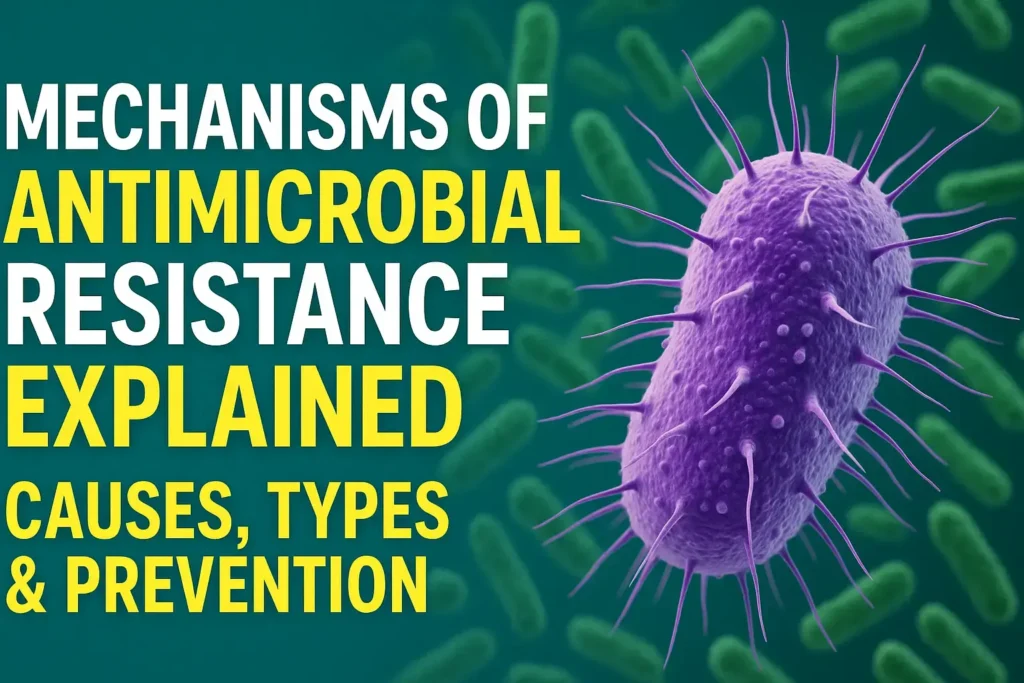
Ever taken antibiotics and they just didn’t work? You’re not the only one.
More and more people are facing this same problem. Infections that used to clear up with a few pills are now sticking around. Why? Because bacteria are getting smarter. They’re learning how to beat the drugs we use to kill them.
This is called antimicrobial resistance. It’s not just a science term. It means longer sickness, higher hospital bills, and treatments that fail when you need them most.
We need to understand what’s really going on to fix it. The mechanisms of antimicrobial resistance show how bacteria fight back. These tricks help them survive and spread.
The Nigerian National Antimicrobial Stewardship Taskforce is working hard to stop it. They’re raising awareness and helping people use antibiotics the right way.
You are not alone if you’ve ever asked, “Why isn’t this medicine working?”
Understand What Antimicrobial Resistance Is
Antimicrobial resistance means the drugs we use to kill bacteria stop working. The bacteria don’t die. They survive. And they come back stronger by mutation.
Interesting Fact: You are not becoming immune to antibiotics. Bacteria are.
This happens a lot more than people think. You might get a urinary tract infection. You take medicine. Nothing happens. Or maybe you get strep throat. Same story. The meds don’t work. You feel worse.
That’s because those bacteria have found a way to fight back. They’ve learned how to dodge the drugs.
These tricks are called mechanisms of antimicrobial resistance. Some bacteria block the medicine. Others break it down. Some even spit it out before it can work.
Scientists also call them mechanisms of antibiotic resistance. It’s the same idea. Different words. The point is simple. Bacteria will become resistant If we keep using antibiotics the wrong way.
And that’s bad news for everyone.
How Do Bacteria Fight Back?
Bacteria are not passive. When exposed to antibiotics, they try to survive. They have built-in defense systems. These are called mechanisms of antimicrobial resistance.
Some bacteria use one method. Others use several at once. That is why many infections no longer respond to treatment.
Here are the main ways bacteria protect themselves.
Enzymes That Destroy the Drug
Some bacteria produce enzymes. These enzymes break down the antibiotic. The drug loses its power before it can act. This is one of the most common mechanisms of antimicrobial resistance.
Target Site Changes
Antibiotics need to attach to specific parts of the bacteria. That is how they work. But bacteria can change those target sites. The drug can no longer bind. This is a major factor in mechanisms of antibiotic resistance.
Efflux Pumps
Some bacteria can push the drug out. They use efflux pumps for this. These pumps sit in the cell wall. As soon as the antibiotic enters, it is removed. This is one of the key bacterial resistance mechanisms.
Cell Wall Barriers
Some antibiotics cannot even enter the bacteria. The surface changes or becomes thicker. This stops the drug at the outer layer.
These antimicrobial resistance mechanisms work like a shield. They block the medicine before it can do harm.
It is one of the most difficult challenges in treatment. These are strong mechanisms of antimicrobial resistance that allow bacteria to survive.
Bacteria keep changing to stay ahead. That is why resistance is a serious global threat. But when we understand how these bacterial resistance mechanisms work, we have a better chance of fighting back.
Types of Antimicrobial Resistance
These are the types of antimicrobial resistance.
The first type is called intrinsic resistance. The second is acquired resistance.
Intrinsic vs Acquired Resistance
Intrinsic resistance is built-in. The bacteria already have features that protect them from certain antibiotics. That protection is part of their natural structure. Some antibiotics will never work on them.
Acquired resistance is different. It develops over time. The bacteria may pick up resistance genes from other bacteria. Or they may change during treatment. These changes allow them to survive even powerful drugs.
Many dangerous infections start like this. MRSA and drug-resistant TB are examples. These are hard to treat because they use smart bacterial resistance mechanisms.
Knowing the types of antimicrobial resistance helps us find better treatments.
Did You know?
Both types rely on the same basic mechanisms of antimicrobial resistance to stay alive.
Intrinsic vs Acquired Resistance
| Feature | Intrinsic Resistance | Acquired Resistance |
| How it starts | Already present in the bacteria | Develops through mutation or gene transfer |
| Can it spread to others? | No | Yes |
| Found in all strains? | Yes (if it’s part of that species) | No (varies between strains) |
| Example organisms | Pseudomonas aeruginosa | Mycobacterium tuberculosis, MRSA |
| Link to resistance rise | Natural limit to treatment | Major cause of new resistance cases |
Root Causes of Antimicrobial Resistance
Bacteria don’t become resistant without help. Our choices are often the reason they adapt.
• Overuse of Antibiotics
Antibiotics are often used when they aren’t needed. People take them for viral colds or flu. In farms, animals are sometimes given antibiotics too often. This overuse creates strong bacteria that resist treatment.
• Incomplete Prescriptions
Many people stop taking antibiotics once they feel better. But some bacteria survive. These leftover ones can become stronger. They learn how to resist the same drugs in the future. This leads to powerful mechanisms of antimicrobial resistance.
• Poor Sanitation and Weak Testing
In areas with poor hygiene, bacteria spread easily. When lab testing is not done properly, doctors may give the wrong medicine. This gives bacteria more time to fight back using antimicrobial resistance mechanisms.
• Response from Nigeria
The Nigerian National Antimicrobial Stewardship Taskforce is working to stop this. They support smart antibiotic use and better diagnosis. Their efforts aim to slow down dangerous mechanisms of antimicrobial resistance and protect public health.
Steps to Prevent Antimicrobial Resistance
Antimicrobial resistance is growing fast. But we are not helpless. Simple actions can slow it down. Here’s what we can do.
1. Always finish your antibiotics
Even if you feel better, keep taking the medicine. Stopping early leaves strong bacteria alive. That is how mechanisms of antimicrobial resistance build up. These bacteria come back harder to kill.
2. Never use leftover medicine
Leftover antibiotics may not match your illness. Taking them without a proper test leads to wrong treatment. This gives bacteria a chance to develop bacterial resistance mechanisms.
3. Get tested before taking antibiotics
Do not take antibiotics based on guesswork. A test helps doctors choose the right drug. This lowers the chance of creating new mechanisms of antimicrobial resistance.
4. Help spread awareness
The Nigerian National Antimicrobial Stewardship Taskforce is leading campaigns to fight resistance. Share their message. Awareness helps everyone make better choices.
5. Support research and new treatments
We need better tools to fight resistant bacteria. New drugs and options like phage therapy are being studied. Science plays a key role in stopping mechanisms of antimicrobial resistance.
Conclusion
We are losing the fight against dangerous infections. The rise of mechanisms of antimicrobial resistance is a warning. If we keep using antibiotics the wrong way, they will stop working. The results could be deadly.
But we can still act. Use antibiotics only when needed. Finish every dose. Share what you know. Small steps help protect millions. Support the Nigerian National Antimicrobial Stewardship Taskforce. Their work is part of the solution. So is your awareness.
FAQs
What are the mechanisms of antimicrobial resistance?
Mechanisms of antimicrobial resistance are:
- They may break down the drug
- Block it from entering.
- Change the target it attacks
- Remove it using pumps.
Is antimicrobial resistance easy to reverse?
While we can reduce its impact, complete reversal is difficult. It requires preventive steps and Awareness of antimicrobial resistance mechanisms.
How is Nigeria tackling this problem?
The Nigerian National Antimicrobial Stewardship Taskforce lead national campaigns, promotes responsible use, and supports research to address resistance.
What’s the difference between bacterial resistance and immunity?
Bacterial resistance: how bacteria adapt to survive antibiotics.
Immunity: body’s natural defence against disease.


